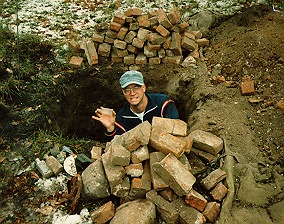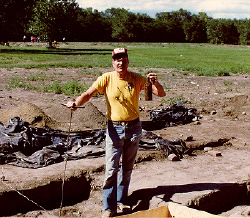One Man's Trash...Another Man's Treasure
by Bob Kolbe
Maybe it was reading as a youth about the digging of King Tut's tomb,
or that the Middle East has large heaped hills called "tells" that are
city garbage piles, that kindled my interest in archeology. It has, it
seems, always been an interest. However, little was done to be active in
that pursuit, with the exception of occasionally searching for arrowheads.
All that changed five or six years ago. An acquaintance of a friend moved
to Sioux Falls to begin his medical residency. Tim Wolter had the expertise
and I had the desire. Under his guidance we proceeded to do amateur archaeology
that was close to home.
How, you ask, can one do archaeology close to home?
Tim and I are bottle collectors and one of the best places to fund
old bottles is underground. Why? If they weren't broken when buried, then
they should still be unbroken today.
 Where
do we look? Where
do we look?
One place is ash pits behind old homes (that's the hole in the ground
where stove ashes were put so as to keep them from blowing around and burning
up wooden buildings). The second place is old privies (the little house
behind the big house used for, oh, you know). I suppose you want to know
more about this. I heard some of you say "Privies! Yuch!" So, I'd do some
explaining right here. Our interest is confined to ash pits and privies
that date prior to World War 1. There are a couple of reasons for this.
One is after this date all bottles are totally machine made and very few
are embossed with product or merchant name. The second reason is the primary
contents of the privy after this date get closer to food than soil. The
older privies primary contents have turned to a highly fertile soil.
|
How do we find this buried treasure?

Using a "T" shaped steel rod as a probe, we push it into the ground until we
locate an area of previously disturbed soil. With a little practice, one can
tell size of site, depth of cover material, and a little about the contents in
the potential dig site. Now the fun begins as the treasure we hope to find has
been located. The sod is taken off the top and put in one pile and the black
dirt in another. On good lawns we pile everything on a canvass as it keeps the
area clean and makes refilling the treasure hole easier. |
How deep do we go?
To the bottom of course (sorry for being flip). We have dug as shallow
as four feet and as deep as ten feet. From the pictures, you can tell we
work hard for our hobby and treasure. After using the probe 75 to 10~ times
to locate a site, then digging to an average depth of six feet, refilling
the "treasure hole" and restoring the surface as good as possible, we've
earned our trophies, if any are to be found.
This leads to the next question, "What do you find?"
A partial list of objects found on a variety of digs in the last seven
years would include wine, whiskey, beer, soft drink, druggist and patent
medicine bottles, boys and girls toys, shoes, crockery, dishes and rusty
cans. Most everything is broken but occasionally accidents do happen and
a good usable item was thrown away or dropped. That may help explain why
we have also found parts of two rusty pistols, a rusty cylinder record
player and an upper plate of false teeth. We imagine the former owner of
the teeth had a few choice words to say about the loss.
So, you ask, "What do you do with all this stuff you find?"
Most of what is dug is replaced in the refill process. Usually everything
is cracked, broken or rusty. The occasional bottle that is complete has
little interest unless the merchant's name or name of the contents is embossed
in the glass. Even then, we only want items we have not previously added
to our collections .
No bottles were made in our area. They were produced in the east, and
then made to order for the local merchant. My digging partner, Kim Johnke,
is collecting those bottles with Sioux Falls merchant names embossed. He
and I have been digging together for six years now. I am trying to build
a collection of bottles embossed with Dakota Territory merchant names.
We do find things that as singular items, we add to our collections
such as the false teeth or an unusual colored shaped or embossed bottles
(such as "Dr. Noid's Antiseptic Cure for Dandruff, Eczema, and Falling
Hair" - Canton, So. Dak.). We've learned much about our history and can
tell you a little about the people who used these ash pits. We feel we
help preserve items of historical interest. Beside putting them in our
collections, we give items to museums and historical societies. As a hobby,
digging may be unusual, but we enjoy our hobby. It puts us in the fresh
air, gives us exercise, and the tools are not expensive. Diggers are interesting
people. My acquaintances include an electrical engineer, school teachers.
vocational counselors, a state senator and a print shop owner just to name
a few. They all agree - digging beats waiting for a fish to bite. Remember,
after you have dug fifty privies, you have earned the title P.H.D. (Privy
Hole Digger).
Home
| Clocks | Bottles
| Photos

1301 S Duluth
Sioux Falls SD 57105
605-332-9662
R.E.Kolbe
|
 Where
do we look?
Where
do we look?
